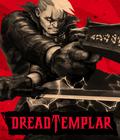Modern gamers have coined the term "boomer shooter" for first-person shooters that emulate some of the features of titles that created the genre in the first place: fast movement, run-and-gun gameplay, and light puzzle-solving. Not all of these things were necessarily true about the classics, but that's what the new term has stuck with. Some games have stuck to the blueprint, while others have tried to incorporate modern features into the mix. Dread Templar goes with the latter, and while it isn't perfect, it does its job very well.
Shooters that fit in this genre don't necessarily have much of a story, and Dread Templar is no exception. You play the role of a Dread Templar, a demonic bounty hunter sworn to vanquish evil as revenge for the death of your parents and grandfather. That's all you need to motivate you, and while some may have wanted more of a tale to go with the gunplay, the less-than-stellar writing in the cut scenes, which appear between a few levels and feature stilted delivery, would make you think otherwise.
As far as the core mechanics go, it does the expected things from a modern interpretation of the boomer shooter, and it does them well while implementing some new things along the way. As far as movement goes, you're extremely zippy and can traverse most levels in record time if you ignore everyone. This is an aspect of the genre that most games get wrong, as movement on those classic was never this fast unless you overclocked your PC to go faster than the game was originally programmed to go, but with most people assuming this is canon, expect any playable character in the genre to move around as if the Run button were permanently active (and with a speed multiplier in tow). The movement isn't fast enough to feel out of control, and it works great whether you're using the standard keyboard/mouse combo or a gamepad. You can jump, which wasn't always common with first-person shooters, and you can also dash, which works for evading enemies or crossing chasms.
The gunplay is satisfying and interesting, as it seems to take inspiration from several sources. There's an armor system, but it doesn't regenerate and neither does your health, forcing you to search for health packs and try to play a little less recklessly. Your guns consist of a good mix of things from pistols to Uzis to shotguns as well as more powerful things, like trap launchers and rocket launchers. Pistols and Uzis are dual-wielding weapons, but they take a page from the original Doom in that they share the same ammo pool. The same goes for the shotguns; the single- and double-barreled versions use the same shells, and you can switch to either with the click of a button or the use of a weapon wheel. Reloading is present, so don't expect to unload the full ammo cache without pause. One of the more interesting things here is that you'll be completely dependent on breaking apart crates and other objects to scrounge for ammo; drops from fallen enemies only seem to occur during boss fights.
Speaking of monsters, the bestiary takes on all manners of the grotesque, including the shambling undead, tiny spiders, humanoid scorpions, and lunging swordsmen. Combined with the setting, it'll remind you of a mix of what you'd see in Doom, Quake, and Heretic in that they're more organic but still take on a variety of attack patterns. Bosses are also large and varied, but they all have basic AI patterns. Just about every foe resorts to rushing you, while anyone wielding a projectile keeps a distance but chases you down if you run away. Only a few of the more advanced enemies seem to employ different tactics, but you're not going to find the smart AI from some of the better modern shooters on the market. Boss fights are tough due to the multitude of minions that accompany the large bosses, but most can be taken down with endurance and constant circle-strafing. You don't really need advanced tactics, but this throwback to first-person shooter strategy is welcome.
Two of the most interesting weapons in your arsenal also seem like the two things that initially feel out of place. Since you can't melee with the butt of your gun, you have dual katanas that strike well and fast when you're dry on ammo. It does have an alternate fire mode, where you can combine both katanas and throw it like a javelin. The damage output is high, and it also comes with a long enough wait time that you'll only use it if you want to change things up and commit more hit-and-run attacks. The other interesting weapon in your arsenal is a bow. The damage is good, and you have a slower firing rate compared to other guns. You have the benefit of unlimited arrows, but much like your dash and katana throw, there's a cooldown time that's long enough that you'll only use it when you're in a bind.
Another interesting aspect of combat is the upgrade system. Every level contains at least one shrine, where you can upgrade your stats or weapons. Your upgrades depend on you having two items at hand anytime you visit a shrine: a red gem to open the slot and a coin that outlines the ability you want to add. The silver ones tend to be benign, like adding a higher ammo cap or increasing the damage, while the gold coins tend to lead to more interesting things, like giving your shotgun a sniper ability or making your arrows connect to other enemies via electric shock. The only flaw is that the game fails to tell you that the slots are all in different tiers, and the cost to unlock each slot differs because of it. Without that knowledge, you may frantically click around, wondering why you can't equip a gold coin to your katana slot when you only have one red gem.
The last major aspect inspired by the classics is the level design. While the verticality is new, Dread Templar sticks to maze-like levels, with doors that need to be opened via switches or different colored key cards. Secrets are plentiful, and you can pull up a guide to show how many secrets are in a level. Around half of the secrets hide more ammo or health, but some of the better ones hide challenges that usually result in a big upgrade. The payoff makes it worth it to hunt for secrets, even if you have to hug walls, duck everywhere, and swim in all bodies of water until you stumble upon the goodies.
The mix of classic and modern elements is good, as it makes for some measured pacing where you get good stretches of action and little breaks to replenish ammo or upgrade before going into another gunfight. It nails the exciting parts of gunfights rather well, and it initially feels similar to other top titles of the genre. There are only a few bits where things feel off, such as needing to use the jump button to climb ladders or having enemy explosions splash through walls and floors. The game also doesn't do a great job of conveying that you're hit; your grunts are low volume-wise, and there's no indicator to show that you were hit. Otherwise, the only real complaint is that it doesn't do much here to differentiate itself beyond the cool upgrade system.
Beyond the campaign, Dread Templar includes Guardian mode. The mode is different from the rest of the game in that it is more of a defensive arena shooter, where you'll need to protect a crystal in the middle of the map from waves of enemies. Fallen enemies drop ammo on occasion, but the big change comes from a currency system, where killed enemies automatically yield coins that can be used to buy ammo, weapons, and other temporary things, like increased weapon damage or a guardian to help you kill enemies for a short while. The good news is that your progress carries over into this mode, so even though you'll have to buy the trap gun to use it, you'll do so with all of the upgrades you've placed on it up to that point. The bad news is that the progression only carries over from one difficulty level to another, so you can't take your progress from Normal into Easy. Also, aside from the thrill of constant combat, there's not much incentive to keep going. There are no leaderboards, and there are no boosts that you can bring back to the campaign.
For the most part, the presentation is done well. The graphics go for a high-resolution retro look; wall textures look clean at first glance but sport visible pixels when viewed closely for even a few seconds. The character animations are smooth at times, but stuttering occurs when larger creatures are taken down. While that would normally be frowned upon in other titles, it seems charming here due to the game's intention of looking retro with a few modern touches. The same could be said for the character designs, which are very low-polygon in certain areas, and the overall color scheme goes for the dirty brown look, with few other colors used for contrast. It works well since the game runs at a very high frame rate with minimal effort. Meanwhile, with some of the sound effects, like gunfire lacking punch, the audio is completely dependent on the music to carry things. In that regard, it works well since a metal soundtrack blasts in your ears at every opportunity. It works very well for the setting, with the only complaint being that every death means having the songs reset to the very beginning instead of just continuing.
Those wanting to play on the Steam Deck will find that the game works quite well on the handheld PC. Right out of the box, Dread Templar runs at a rock-solid 60fps with no dips. The retro aesthetic fits nicely on the screen, while the controls benefit greatly from having default controller support. Battery life at a full charge gives you a little over four hours of playtime, which is quite good even if the game lacks any tweakable options to extend the playtime.
Dread Templar is a good example of a solid boomer shooter. It's fast, the enemies are dumb yet formidable, and the level design begs for exploration. The upgrade system is quite nice but doesn't show off its capabilities until you get further into the game. Weapon types are fine until you get them really powered up. While some things are a bit unfair, with explosions reaching far beyond their intended range and enemies refusing to drop ammo, Dread Templar remains an adrenaline-pumping experience that you'll return to — as long as you aren't expecting anything revolutionary.
Score: 8.0/10
More articles about Dread Templar











 Dread Templar is a fast-paced first-person shooter that combines elements from both modern retro shooters and classics from the '90s like Doom, Quake and Hexen.
Dread Templar is a fast-paced first-person shooter that combines elements from both modern retro shooters and classics from the '90s like Doom, Quake and Hexen.






















